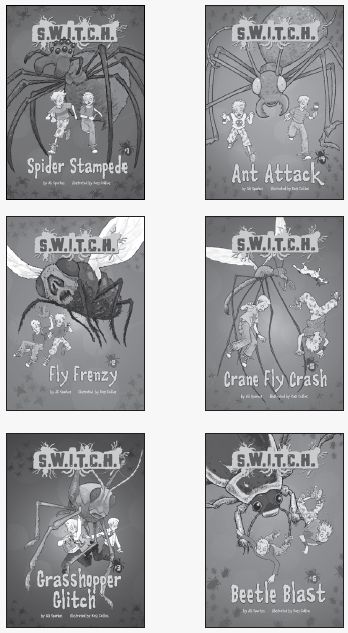Gecko Gladiator (9 page)
Authors: Ali Sparkes

“No! You have to hum!” cried Danny, and he stuck the kazoo in his mouth, closed his lips around it, and hummed a little tune. It came out as a lively buzz.
“You can hum,” Josh said. “So you don't win. Now let's see ⦔

He put the other kazoo to his lips and started humming. Nothing came out except a dull murmur. No buzzing. No humming. Josh grinned at Danny. “I win,” he said.
And he tugged at the little round porthole-style window on the top of the metal barrel until it came off. Underneath this should have been a piece of tissue paper. But instead, he found something small and round. A lump of glass.
He tipped it onto his palm.
One perfect glass marble with a ribbon of color running through it. Getting out his magnifying glass, Josh could just make out the code insideâand the hologram of what looked like ⦠a whale. “Yupâit's another S.W.I.T.C.H. marble,” he confirmed. “But I think this one must be for you,” he chuckled, handing it to Danny.
“Oh very funny,” Danny said.
The marble was pink.



amphibian:
an animal that can live on land and in water
antidote:
something that takes away the bad effects of a poison or disease
arachnid:
A member of the group of animals that includes spiders and scorpions
cellular:
made from cells
hijack:
to take control of something by force
hologram:
a type of photograph made by laser beams. A hologram appears to have depth as well as height and width.
laboratory:
a room or building equipped for scientific work
mammal:
any animal of which the female gives birth to live young and can feed them with her own milk
pigment:
a substance that colors something
prosecute:
to prosecute someone is to make them go to a court of law to be tried for a crime
reptile:
a cold-blooded animal that creeps or crawls. Lizards and snakes are reptiles.
scales:
the thin, overlapping parts on the outside of fish, snakes, and other animals
serum:
a kind of fluid used in science and for medical purposes
setae:
small hairlike pads responsible for the animal's ability to cling to vertical surfaces
snout:
the front part sticking out from an animal's head, with its nose and mouth
territorial:
an animal that guards and is defensive of an area of land it believes to be its own
transparent:
something you can see through

BOOKS
Want to brush up on your reptile and amphibian knowledge? Here's a list of books dedicated to slithering and hopping creatures.
Johnson, Jinny.
Animal Planet⢠Wild World: An Encyclopedia of Animals
. Minneapolis: Millbrook Press, 2013.
McCarthy, Colin.
Reptile
. DK Eyewitness Books. New York: DK Publishing, 2012.
Parker, Steve.
Pond & River
. DK Eyewitness Books. New York: DK Publishing, 2011.
WEBSITES
Find out more about nature and wildlife using the websites below.
National Geographic Kids
http://kids.nationalgeographic.com/kids/
Go to this website to watch videos and read facts about your favorite reptiles and amphibians.
San Diego Zoo Kids
http://kids.sandiegozoo.org/animals
Curious to learn more about some of the coolest-looking reptiles and amphibians? This website has lots of information and stunning pictures of some of Earth's most interesting creatures.
US Fish & Wildlife Service
http://www.nwf.org/wildlife/wildlife-library/amphibians-reptiles-and-fish.aspx
Want some tips to help you look for wildlife in your own neighborhood? Learn how to identify some slimy creatures and some scaly ones as well.
CHECK OUT ALL OF THE TITLES!
TITLES!



Ali Sparkes grew up in the wilds of the New Forest, raised by sand lizards who taught her the secret language of reptiles and how to lick her own eyes.
At least, that's how Ali remembers it. Her family argues that she grew up in a house in Southampton, raised by her mom and dad, who taught her the not terribly secret language of English and wished she'd stop chewing her hair.
She once caught a slow worm. It flicked around like mad, and she was a bit scared and dropped it.
Ali still lives in Southampton, now with her husband and two sons. She likes to hang out in the nearby wildlife center, spying on common lizards. The lizards are considering legal action â¦
